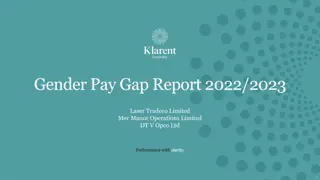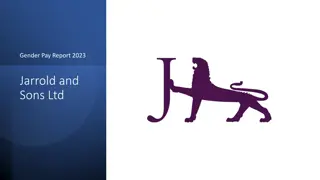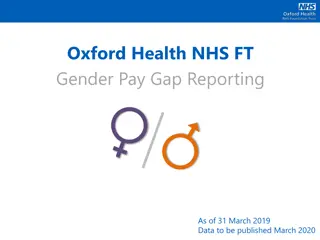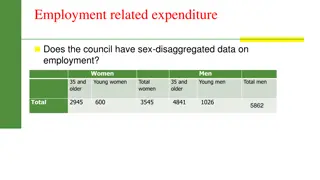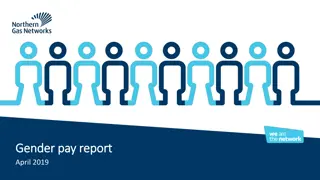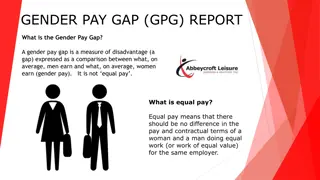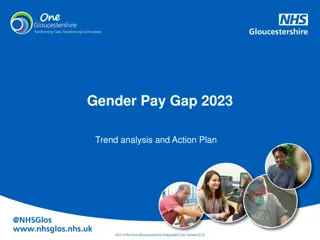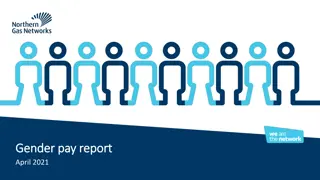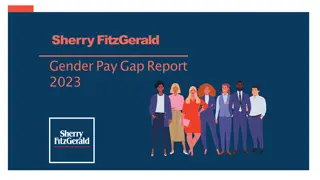
Understanding Palletways UK Gender Pay Gap Analysis 2024
Explore the Gender Pay Gap Analysis for Palletways UK as of April 5, 2024, in compliance with the Equality Act 2010. Learn about the mean and median gender pay gaps, bonus gaps, and workforce distribution across pay quartiles. Discover why gender pay gaps exist and how Palletways is committed to equal opportunities and fair treatment.
Download Presentation

Please find below an Image/Link to download the presentation.
The content on the website is provided AS IS for your information and personal use only. It may not be sold, licensed, or shared on other websites without obtaining consent from the author. If you encounter any issues during the download, it is possible that the publisher has removed the file from their server.
You are allowed to download the files provided on this website for personal or commercial use, subject to the condition that they are used lawfully. All files are the property of their respective owners.
The content on the website is provided AS IS for your information and personal use only. It may not be sold, licensed, or shared on other websites without obtaining consent from the author.
E N D
Presentation Transcript
Palletways Gender Pay Gap Analysis 2024
Gender Pay Gap Analysis for Palletways UK Introduction Table 1: Pay quartiles by gender This report shows Palletways Gender Pay Gap at 5th April 2024 as required by the Equality Act 2010. This table shows our workforce divided into four equal-sized groups based on hourly pay rate. Band A includes the lowest-paid 25% of employees (the lower quartile) and band D covers the highest-paid 25% (the upper quartile). This is our annual gender pay gap report for the snapshot date of 5 April 2024. Our mean gender pay gap is 6.8%. Our median gender pay gap is 18.6%. Our mean gender bonus gap is 9.5%. Our median gender bonus gap is 18.6%. The proportion of male employees receiving a bonus is 34% and the proportion of female employees receiving a bonus is 30%. Band A Males 62.5% Females 37.5% What is included in this band? All employees whose standard hourly rate is within the lower quartile All employees whose standard hourly rate is more than the lower quartile but the same or less than the median All employees whose standard hourly rate is more than the median but the same or less than the upper quartile All employees whose standard hourly rate is within the upper quartile 92.3% 7.7% B 93.5% 6.5% C 82.7% 17.3% D A quartile is one of four equally sized groups created when you divide a selection of numbers that are in ascending order into four. The "lower quartile" is the lowest group. The "upper quartile" is the highest group. The figures in this table have been calculated using the standard methods used in the Equality Act 2010 (Gender Pay Gap Information) Regulations 2017.
Why do we have a gender pay gap? Across the UK economy, men are more likely than women to be in senior roles (especially very senior roles at the top of organisations). Women are more likely than men to be in front-line roles at the lower end of the organisation. Men are more likely to be in technical and IT-related roles, which are paid more highly than other roles at similar levels of seniority. Women are also more likely than men to have had breaks from work that have affected their career progression, for example to bring up children. They are also more likely to work part time, and many of the jobs that are available across the UK on a part-time basis are relatively low paid. Legally, men and women must receive equal pay for: the same or broadly similar work; work rated as equivalent under a job evaluation scheme; or work of equal value. We are committed to equal opportunities and equal treatment for all employees, regardless of sex, race, religion or belief, age, marriage or civil partnership, pregnancy/maternity, sexual orientation, gender reassignment or disability. We have a clear policy of paying employees equally for the same or equivalent work, regardless of their sex (or anything else listed above). We: This pattern from the UK economy as a whole is reflected in the make-up of our organisation. Most customer service roles at our sites are held by women and most line managers and senior managers are men. Also, most of the relatively highly paid director level roles are held by men and not women. carry out regular pay and benefits audits; provide regular equal pay training for all managers and staff members who are involved in pay reviews; and evaluate job roles and pay grades to ensure fairness. The table above shows our workforce divided into four equal-sized groups based on hourly pay rate. Band A includes the lowest-paid 25% of employees (the lower quartile) and band D covers the highest-paid 25% (the upper quartile). If we had no gender pay gap, there would be an equal ratio of men to women in each band. However, instead, 37.5% of the employees in band A are women and 62.5% men. The percentage of male employees increases throughout the remaining bands, from 92.3% in band B to 93.5% in band C and then decreases to 82.7% in band D. We are confident that our gender pay gap is not because we pay men and women differently for the same or equivalent work. Instead, our gender pay gap is because men and women work in different roles and those roles have different salaries. Our mean and median gender bonus gaps are: 9.5% and 18.6% respectively. This is because men at Palletways are more likely to occupy positions which receive a larger bonus. 34% of men at our organisation received a bonus in the 12 months up to 5 April 2024. For women this was 30%. This is because more men hold positions where they are entitled to bonuses.
What are we doing to address our gender pay gap? Over the next year, we will: We are not happy with our gender pay gap even though it compares favourably with others. We are committed to doing everything we can to reduce the gap. However, we also know this is a difficult task. For example, we have no control over what people choose to study or the career choices that they make. Commit to reviewing our Pay & Benefit strategy on a regular basis; Continue to collaborate with the Armed Forces redeployment partners to attract veterans and their family members; Continue to use apprenticeship schemes in other areas of the business such as IT, HR, marketing and customer service with a view of attracting more women into the business. To provide more flexible/part-time opportunities to attract a diverse workforce. So far, we have taken the following steps to promote gender diversity: Introduced an enhanced maternity leave and pay policy. Introduced a more flexible approach to hybrid and home working. Introduced more flexibility on working times to suit childcare needs. Any further initiatives launched throughout the year will be reported on the company intranet. I, Robert Gittins, Managing Director, confirm that the information in this statement is accurate. By themselves, none of these initiatives will remove the gender pay gap - and it may be several years before some have any impact at all. In the meantime, every year we will tell you what we're doing to reduce the gender pay gap and the progress that we're making. Signed Right now, we have plans to extend our evidence-gathering. We are asking for your help to work out the barriers and the drivers for women employees. Date 19th March 2025


